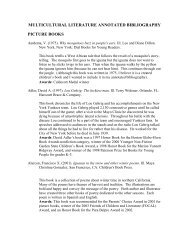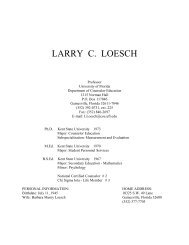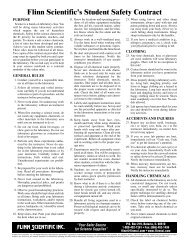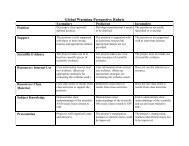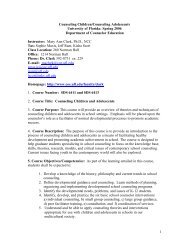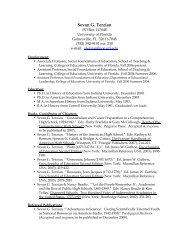The Effects of Distance Education on K-12 Student Outcomes: A ...
The Effects of Distance Education on K-12 Student Outcomes: A ...
The Effects of Distance Education on K-12 Student Outcomes: A ...
Create successful ePaper yourself
Turn your PDF publications into a flip-book with our unique Google optimized e-Paper software.
programs in which students participated approximately five days per week, and the other study<br />
did not indicate the frequency <str<strong>on</strong>g>of</str<strong>on</strong>g> student participati<strong>on</strong>.<br />
<str<strong>on</strong>g>The</str<strong>on</strong>g> studies encompassed a variety <str<strong>on</strong>g>of</str<strong>on</strong>g> instructi<strong>on</strong>al features. <str<strong>on</strong>g>The</str<strong>on</strong>g> bulk <str<strong>on</strong>g>of</str<strong>on</strong>g> the results, 75%,<br />
occurred in the sec<strong>on</strong>dary grades, 6-<strong>12</strong>. <str<strong>on</strong>g>The</str<strong>on</strong>g> other results c<strong>on</strong>cern elementary age children, in<br />
grades 3-5. Results from seven academic c<strong>on</strong>tent areas were reported. Thirty percent <str<strong>on</strong>g>of</str<strong>on</strong>g> the<br />
results came from tests <str<strong>on</strong>g>of</str<strong>on</strong>g> reading ability, followed by mathematics, which accounted for 26% <str<strong>on</strong>g>of</str<strong>on</strong>g><br />
the results. Writing was the subject for 16% <str<strong>on</strong>g>of</str<strong>on</strong>g> the results, science was the topic <str<strong>on</strong>g>of</str<strong>on</strong>g> 14%, and<br />
social studies made up 9% <str<strong>on</strong>g>of</str<strong>on</strong>g> the results. Three percent <str<strong>on</strong>g>of</str<strong>on</strong>g> results came from physical educati<strong>on</strong><br />
comparis<strong>on</strong>s, and <strong>on</strong>e percent from a test <str<strong>on</strong>g>of</str<strong>on</strong>g> listening. Nati<strong>on</strong>al tests were used to compare<br />
outcomes in <strong>on</strong>e study, state tests were used in nine studies, teacher made tests were used in two<br />
studies, and <strong>on</strong>e study reported data from both state and nati<strong>on</strong>al tests.<br />
Overall <str<strong>on</strong>g>Effects</str<strong>on</strong>g> <str<strong>on</strong>g>of</str<strong>on</strong>g> K-<strong>12</strong> <str<strong>on</strong>g>Distance</str<strong>on</strong>g> <str<strong>on</strong>g>Educati<strong>on</strong></str<strong>on</strong>g><br />
<str<strong>on</strong>g>The</str<strong>on</strong>g> analysis resulted in an overall weighted effect size not significantly different from zero, a<br />
result that is in line with the results <str<strong>on</strong>g>of</str<strong>on</strong>g> recent meta-analyses <str<strong>on</strong>g>of</str<strong>on</strong>g> distance educati<strong>on</strong> (see Table 1),<br />
which tend to show that distance educati<strong>on</strong> is as effective as classroom instructi<strong>on</strong>. <str<strong>on</strong>g>The</str<strong>on</strong>g> weighted<br />
mean effect size across all results was -0.028, with a standard error <str<strong>on</strong>g>of</str<strong>on</strong>g> 0.045 and a 95%<br />
c<strong>on</strong>fidence interval from -0.116 to 0.060. <str<strong>on</strong>g>The</str<strong>on</strong>g> average unweighted Cohen’s d was -0.034, and the<br />
median effect size was -0.015. <str<strong>on</strong>g>The</str<strong>on</strong>g> effect sizes varied c<strong>on</strong>siderably am<strong>on</strong>g the studies (see Figure<br />
1). Unweighted effect sizes ranged from -1.158 to 0.597, with a standard deviati<strong>on</strong> <str<strong>on</strong>g>of</str<strong>on</strong>g> 0.157,<br />
indicating that some applicati<strong>on</strong>s <str<strong>on</strong>g>of</str<strong>on</strong>g> distance educati<strong>on</strong> appeared to be much better than<br />
classroom instructi<strong>on</strong> and others were much worse. However, each <str<strong>on</strong>g>of</str<strong>on</strong>g> the fourteen studies and all<br />
except <strong>on</strong>e <str<strong>on</strong>g>of</str<strong>on</strong>g> the 116 outcomes within the studies had individual effect sizes that did not differ<br />
significantly from zero.<br />
Figure 1. Distributi<strong>on</strong> <str<strong>on</strong>g>of</str<strong>on</strong>g> unweighted effect sizes<br />
Number <str<strong>on</strong>g>of</str<strong>on</strong>g> results<br />
Distributi<strong>on</strong> <str<strong>on</strong>g>of</str<strong>on</strong>g> unweighted effect sizes<br />
-1.4 -1.2 -1 -0.8 -0.6 -0.4 -0.2 0 0.2 0.4 0.6 0.8<br />
Effect size<br />
13 <str<strong>on</strong>g>of</str<strong>on</strong>g> 32<br />
100<br />
80<br />
60<br />
40<br />
20<br />
0



